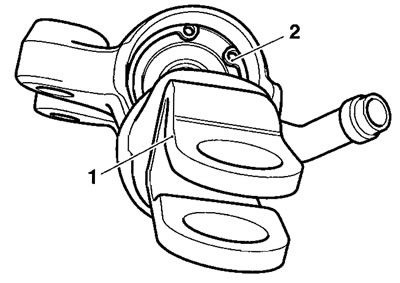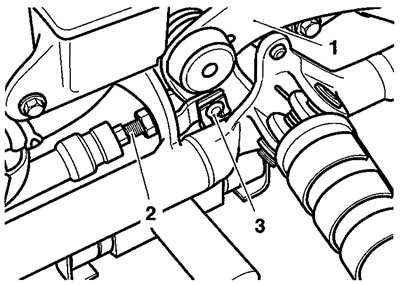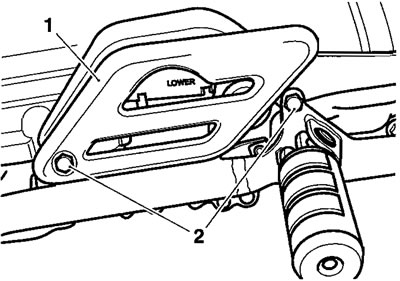Removal
Warning! Before starting work, ensure the motorcycle is stabilised and adequately supported. This will help prevent it from falling and causing injury to the operator or damage to the motorcycle.
1. Remove the seat and disconnect the battery negative (black) lead first.
Caution! To prevent paint damage, do not spill brake fluid onto any area of the bodywork. Spilled brake fluid wili damage paintwork.
2. Drain the fluid from the master cylinder by bleeding the system at the rear caliper until all fluid has been expelled.
3. Remove the master cylinder heel guard.

1. Heel guard; 2. Heel guard fixings
4. Remove the ciip from the brake pedal clevis pin. Remove the clevis pin.

1. Pedal; 2. Pushrod; 3. Clevis
5. Disconnect the feed hose from the brake fluid reservoir at the master cylinder.

1. Reservoir feed hose
6. Disconnect the brake pipe from the master cylinder (discard the sealing washers).

1. Brake pipe
7. Release the bolts securing the master cylinder to the footrest mounting bar. Detach the master cylinder.

1. Footrest mounting bar; 2. Master cylinder bolts
Disassembly
1. Remove the dust cover from the cylinder and push rod.
2. Remove the circlip retaining the pushrod to the cylinder.

1. Circlip
3. Remove the pushrod and piston set from the master cylinder bore noting the relative position of the seals and piston components.

1. Piston
Inspection
1. Check the following for wear, damage, cracks or deterioration:

1. Cylinder bore; 2. Dust cover; 3. Spring; 4. Piston; 5. Pivot bolt
2. Examine the pushrod for distortion and other damage. Replace as necessary.
Assembly
Warning! Never use mineral based grease in any part of the braking system or in any area where contact with the braking system is possible. Mineral based grease will damage the hydraulic seals in the calipers and master cylinders. A dangerous riding condition leading to loss of motorcycle control and an accident could result from use of mineral grease.
1. Lubricate the piston and cylinder with new, clean brake fluid.
Warning! Ensure that the piston and piston seal are fitted facing the same way as noted during removal. A dangerous riding condition leading to loss of motorcycle control and an accident could result from incorrect assembly of the master cylinder.
2. Fit the new piston and seal set into the master cylinder.

1. Piston; 2. Seals (in correct orientation)
3. Apply a small amount of brake grease to the pushrod.
4. Install the pushrod in the master cylinder, compress the spring and retain the assembly with a new circlip.

1. Pushrod; 2. Circlip
5. Refit the master cylinder boot.
Installation
1. Position the master cylinder to the footrest mounting bar.
2. Secure with two new bolts, tightening to 27 Nm.
3. Incorporating new washers to either side of the union, fit the brake pipe. Tighten the union bolt to 25 Nm.
4. Position the reservoir hose to the master cylinder. Retain the hose by positioning the clips as shown below.

1. Reservoir hose; 2. Clips
5. Align the brake pedal with the pushrod, engage the clevis and retain it with the clip. Ensure the clip is fitted as shown below.

1. Pedal; 2. Pushrod; 3. Clevis
Warning! Use only DOT 4 specification brake fluid as listed in the general information section of this manual. The use of brake fluids other than those DOT 4 fluids listed in the general information section may reduce the efficiency of the braking system leading to loss of motorcycle control and an accident. Observe the brake fluid handling warnings given earlier in this section of the manual.
6. Refit the heel guard tightening the fixings to 9 Nm.

1. Heel guard; 2. Fixings
7. Fill and bleed the rear brake system as described on page 15.20.
8. Reconnect the battery positive, (red) lead first.
9. Fit the seat.
10. Check the operation of the rear brake. Rectify as necessary.
Warning! It is dangerous to operate the motorcycle with defective brakes and you must have your authorised Triumph Dealer take remedial action before you attempt to ride the motorcycle again. Failure to take remedial action may reduce braking efficiency leading to loss of motorcycle control and an accident.
